Do you want to send business documents or important files to your boss but got an error because the attachment size is too large?
I’ve also faced the same problem while sending my presentation video. It’s a common issue people face when sending emails with large attachments.

Outlook has a default file size for every email. If the limit exceeds, the user gets an error and fails to send the message. Outlook restricts the file size to maintain better server stability and security and to avoid an outage because of oversized emails.
So, is there any way to send large files in Outlook? Actually, there is! This article will help you learn about the technique of increasing file size limit and the ways to send large files.
Let’s begin!
What is the Outlook Attachment Size Limit?
Outlook’s email client has a maximum of 20 MB limit for attachments in every message. The condition applies to the web and every version of Outlook. If the limit exceeds, your message won’t be sent, and you will receive a The attachment size exceeds the allowable limit message.
Have you ever wondered why you couldn’t add large files in attachments? The email you sent must be encoded in the email infrastructure-friendly format. And the encoding increases the email size by 33%.
Therefore, Microsoft limits the attachment size to avoid system and storage overload and provides a trouble-free service. It protects you from the attackers and from being flooded with oversized emails. However, you can slightly increase the maximum limit by modifying the registry.
Also, there are additional methods to send larger files in your Outlook message. Consider reading the article to know the procedures.
Also, check out our separate post on how to Fix Outlook Could Not Create the Work File in 3 Minutes.
How to Increase File Size Limit in Outlook?
Outlook file size limit can be increased by modifying the registry editor. You can raise it if your mail server supports changing it. The default Outlook attachment limit is 20 MB or 20480 KB. You can maximize the size by increasing it to 25 MB or 25600.
You may receive an error message saying your message exceeds the maximum file size limit. When your mail server supports up to 25 MB, and your file size goes slightly over the default limit, follow the procedures below to increase the size limit.
Here are the steps to increase the Outlook file size limit with the registry editor:
- Press Win + R together.
- Type regedit and click OK.
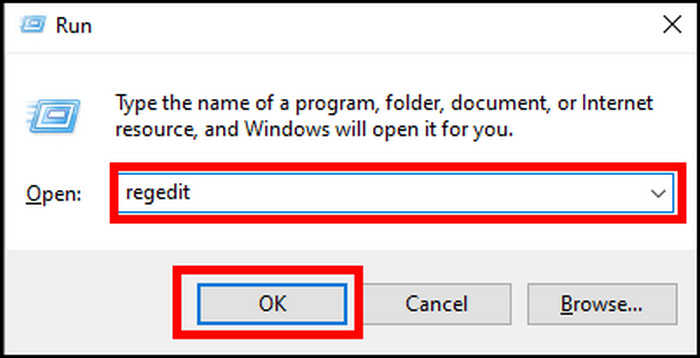
- Navigate to the directory,
- Outlook 2019 and 2016: HKEY_CURRENT_USER\Software\Microsoft\Office\16.0\Outlook\\Preferences
- Outlook 2013: HKEY_CURRENT_USER\Software\Microsoft\Office\15.0\Outlook\\Preferences
- Outlook 2010: HKEY_CURRENT_USER\Software\Microsoft\Office\14.0\Outlook\\Preferences
- Right-click on the right pane and go to New.
- Create a DWORD (32-bit Value).
- Set the file name to MaximumAttachmentSize.
- Double-click on the file.
- Select Decimal from the Base.
- Type 25600 in the Value data and press OK to save it.
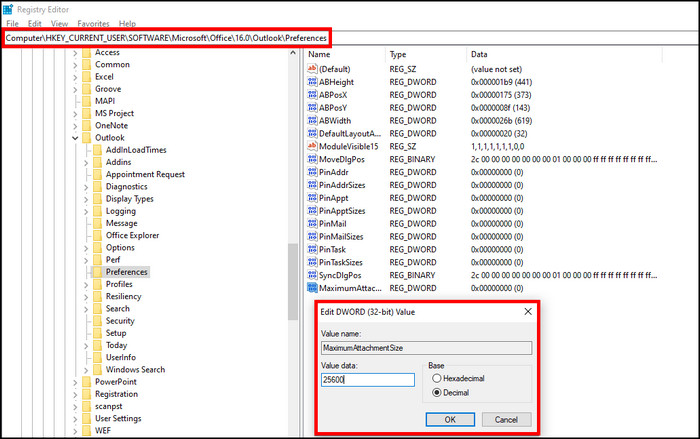
The value data in MaximumAttachmentSize is in kilobyte format. The default value is 20 MB or 20480 KB. In the decimal format, the maximum value limit is 25 MB or 25600 KB.
However, if your attachment size surpasses the mail server limit, you must pursue different ways to send files. Let’s find ways to send large files with Outlook from the passage below.
Check out the easiest way to Fix Outlook Can’t Create File Error When Opening Attachment.
How to Send Large Files with Outlook?
When the file size exceeds the Outlook limit, you can send them by uploading them to the cloud storage, compressing the files, and reducing the image size while sending in messages. Additionally, you can save files in SharePoint if you have an Outlook business account.
Sending a large file in an Outlook message can be stressful if you don’t know the correct procedure. This article will assist you with the extensive file sending method in Outlook. To learn about all the techniques, don’t miss a single point.
Here are the ways to send large files with Outlook:
1. Upload Files to Cloud Service
Many cloud storage services support uploading and sharing large files. Google Drive, OneDrive, Dropbox, and iCloud are the popular cloud storage services you can use to upload large files. Follow the procedures to upload and send files from Outlook.
Here are the procedures to send large files with Outlook:
- Upload your file to cloud storage.
- Copy the file download link.
- Go to your Outlook.
- Click on New Email.
- Paste or embed the link in your message.
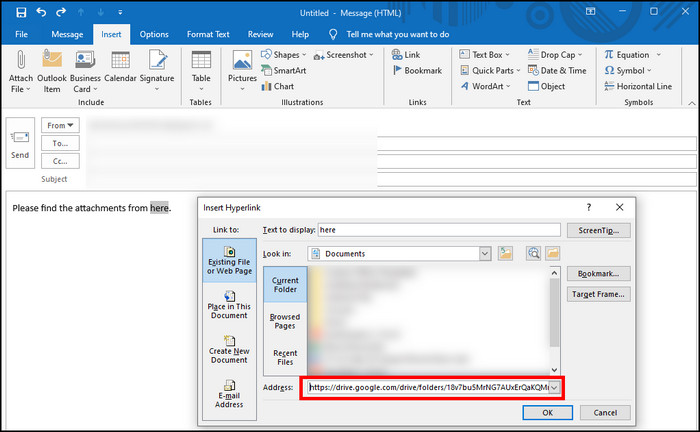
The recipient will open the link from your message to download or open the large files. Before sharing the link, ensure that the file access permission in cloud storage is appropriate for seeing or downloading the files.
2. Compress the File
The file size reduces when you compress or zip them. You can decrease the file size enough to fit in the Outlook attachment. Recipients can download the file and extract them to see the items.
There are different third-party applications to zip or unzip the file. But, the default Windows program for compressing a file is the safest and most suitable. Keep reading the article to learn how to compress and extract the file.
Here is the process of compressing the file:
- Go to files or folders from File Explorer.
- Right-click on the files.
- Press on Send to.
- Select the Compressed (zipped) folder option.
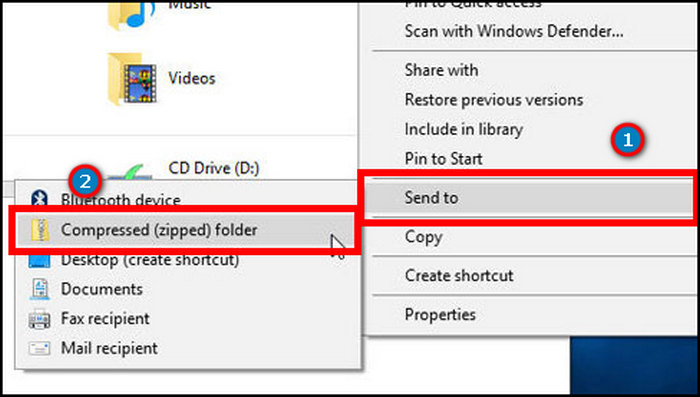
- Rename the zipped file.
Attach the zipped file to your Outlook message attachment and send. The recipient will download and see the files after extracting the zipped file.
Related our new guide post on how to Open and Use a Shared Mailbox in Outlook.
Here are the steps to extract a compressed or zipped file:
- Go to the downloaded location using File Explorer.
- Right-click on the zipped file.
- Select Extract All to unzip the folder.
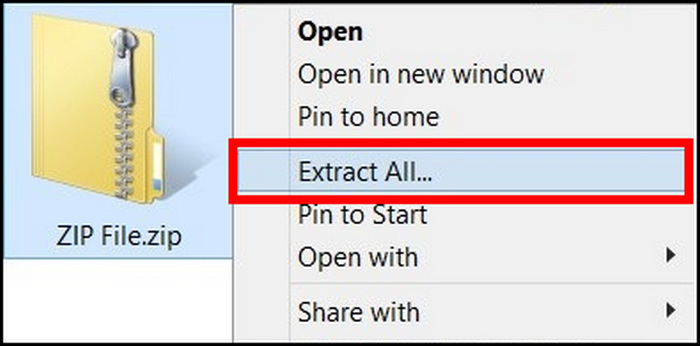
If you want to extract a single file or folder from the zipped folder, follow the procedures below.
Here is the way to extract a single file from the zipped folder:
- Navigate to the file location.
- Double-click on the file.
- Drag the single file or folder and drop it into a new location.
3. Reduce the Image Size
Using the image resizer option in Outlook, you can reduce the large image size when sending them in a message. The image resizer option is disabled by default. To change the option, check out the procedures below.
Here is the procedure to reduce image size:
- Go to your Outlook desktop client.
- Click on New Email.
- Navigate to Insert from the ribbon.
- Press on Attach File and add the large image.
- Click on the File from the top left.
- Go to Info.
- Choose Resize large images when I send this message under the Image Attachments.

- Return to your message.
- Click on Send.
Read the new post on how to fix Outlook Rules Not Running on Shared Mailbox.
You can save the file to a Sharepoint Library using an Outlook business environment. Copy the download link and paste it to the message in Outlook.
Frequently Asked Questions
What is the default file size limit in Outlook?
The default file or attachment size limit in Outlook is 20 MB. If you want to send more that it, you need to upload them in an online storage drive.
How can I send files larger than 25 MB in Outlook?
To send files larger than 25 MB in Outlook, upload them to cloud storage, compress files, resize images and save the file in SharePoint.
What if my zip file is too large to email?
You can send a 25 MB zip file to an email. If the size exceeds, you must upload it to cloud storage and share the download link.
Final Thoughts
Sending files via Outlook attachment is necessary for business and organization. Also, you may need to transfer large files with Outlook on various occasions.
The problem appears when the file size exceeds the default limit. It can be irritating if you can’t send the files in Outlook.
In this article, I’ve provided the most effortless way to increase the file size limits in Outlook, and I believe you can now send large files with Outlook.
Cheers!





The problem of the first solution is many mail server in the world are not allowing attachments of this size !
Another option is to use a third party product like Attach2Cloud, this product allows to upload to OneDrive, SharePoint or Teams the attachments directly from inside Outlook in few seconds through a very easy to use control center.
The limit of the attachment size is then the limit of the size on the cloud service (which is huge ! )
This product can be easily installed and tested, through the fully functional evaluation available on it’s Attach2Cloud website.
https://www.attach2cloud.com/download/
Attach2Cloud is the answer of the 4 other tips, allowing to upload to cloud sites like OneDrive but SharePoint too, optimize file size and compress if needed.
And the mail that goes through the servers is only few kb only as the attachments are links to the cloud service.
There is another solution that could address and replace many manual steps you explain in your article.
Attach2Cloud is a third party product that integrates with Outlook, it allows to drag and drop or attach any file to your message. Even very large ones. Because the files are not attached for real but as soon as you click on send, the product shows a File Control Center that let you choose where you want to upload the files.
To select for each permission, and even a number of days before deleting them from the target folder.
You can use whatever platform you want from OneDrive, SharePoint or Teams.
And the best is that Attach2Cloud integrate the ZipMail/Z-OptimiZr engine, which means that you could zip files, or better optimize XML or images files drastically reducing their size without loosing quality and without compressing them ! That means your recipient could open the file easily.
This product can be easily installed and tested, through the fully functional evaluation available on its Attach2Cloud website.